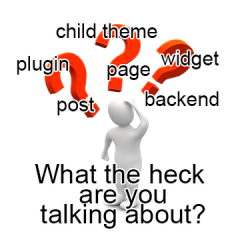 A Glossary of Common WordPress Terms
A Glossary of Common WordPress Terms
A glossary of common WordPress terms is a handy tool to have on hand when you talk to your website consultant or developer. Here are some of the most common.
Theme: A theme is a set of PHP, HTML, CSS and JavaScript files that together create the functionality and look of your website.
Child Theme: A child theme is based on a pre-existing theme, but changes it in various ways. Creating a child theme is much less time consuming than writing a theme from scratch. It has the further advantage of not needing to be maintained by your original developer over time. When the parent theme is updated or fixed, so is your child theme. It is therefore important to base it on a reputable and well maintained parent theme.
Templates: The PHP files in your theme create the layout of a section of your site. There is a template that creates the home page, for example, and others that create the sidebars, footers, individual post views, etc.
Pages: Pages are the ‘static’ elements of your website. They contain information that is not often changed and that give the visitor the basic information about your website. “About Us’ and ‘Contact’ for example are pages. Pages are usually accessible from the navigation bar. They don’t have categories or tags associated with them.
Posts: Articles that you write over time and that appear in a ‘feed’ are posts. In the feed you will usually see excerpts of your posts in chronological order. Clicking on one of them will show you the post in its entirety in a new view. Posts can be organized in categories or by tags.
Frontend: The frontend is what the visitor will see when visiting your site.
Backend, Dashboard, and Administrative Area: These various terms are used to refer to the area where administrators and authors create the contents of a website. You have to be a registered user and have the right kind of access privileges to see this section of the website.
Mockup: Designers create realistic mockups of sections of your website to simulate what the eventual site will look like. Any changes in design should happen when the mockups are reviewed and before the design is implemented in the website.
Widgets: Widgets are readymade pieces of code. From within the WordPress administrative area (Appearance -> Widgets), they can be dragged into a sidebar, footer or custom widgeted area. There are a variety of widgets available in WordPress by default, such as a list of pages, a list of categories, recent posts, or a list of links. There is also a text widget that allows you to add text or an image to your sidebar. There are many more widgets available as plugins.
Plugins: Plugins add functionality to your website. They may consist of a single file or consist of many files that act in concert. Plugins reside in the plugins folder and can be updated and activated from within the plugins section of the administrative area of your site.

